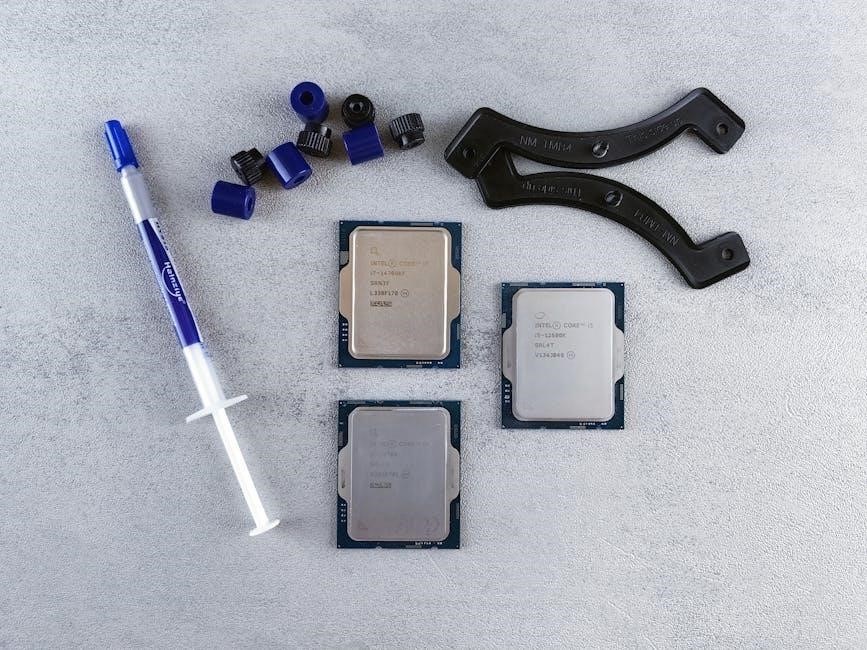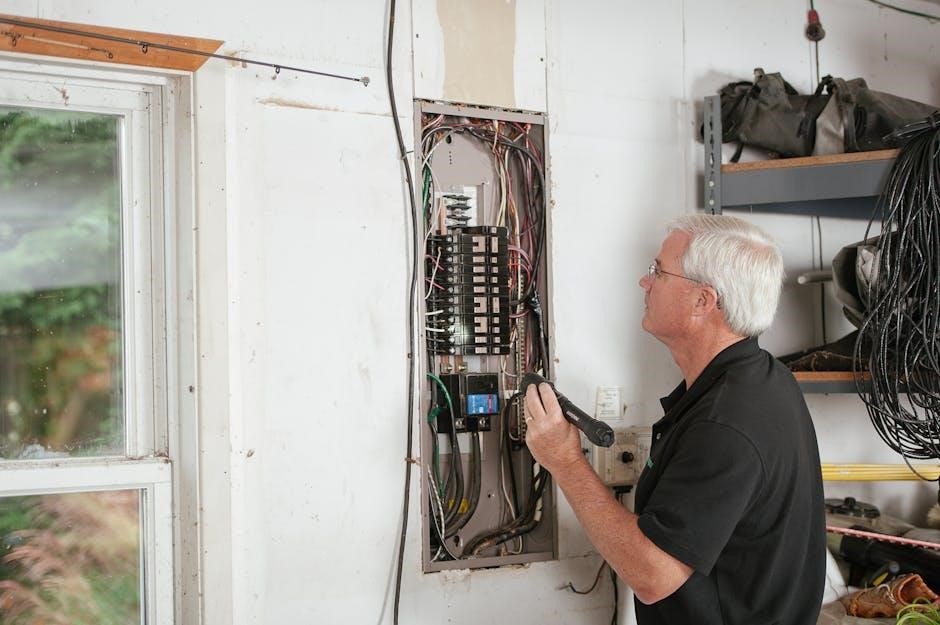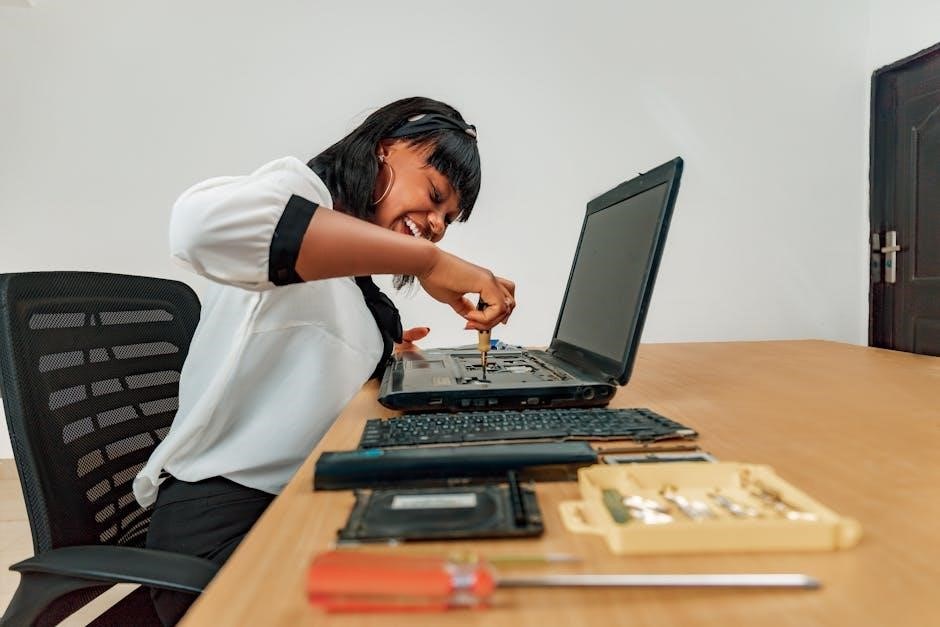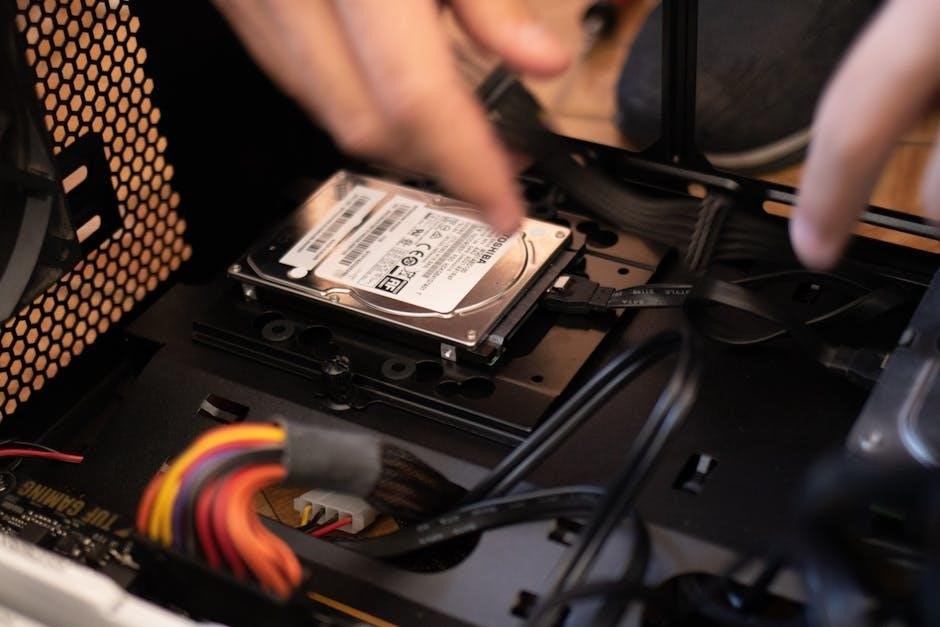Dentemp Repair-It is a convenient, temporary solution for fixing broken or cracked dentures at home. It provides an easy-to-use, emergency repair kit for dental issues, ensuring comfort and functionality until a professional consultation can occur.
Overview of Dentemp Repair-It
Dentemp Repair-It is a quick and affordable solution for temporary denture repairs. Designed for emergency use, it allows users to fix broken or cracked dentures at home. The kit includes a repair compound, mixing pad, and instructions for easy application. It is intended for short-term use, lasting less than 30 days, and is not suitable for loose caps or denture relining. The zinc-free formula ensures safety and fast curing, making it a practical option for immediate relief until professional dental care is sought.
Importance of Proper Denture Repair
Proper denture repair is crucial for maintaining oral health and comfort. Improperly repaired dentures can cause gum irritation, discomfort, and difficulty eating. Long-term use of poorly repaired dentures may lead to permanent changes in the mouth, such as bone and gum reshaping, which can make wearing dentures impossible in the future. Using a reliable repair kit like Dentemp Repair-It ensures temporary fixes are safe and effective, preventing further damage and allowing time to seek professional dental care for a permanent solution.

Materials Needed for Repair
The Dentemp Repair-It kit includes a repair compound, mixing pad, and instructions. Additional tools like a spatula, clean cloth, and container for mixing are also required for proper application.
Components of the Dentemp Repair-It Kit
The Dentemp Repair-It Kit includes a professional-grade repair compound, a mixing pad, and clear step-by-step instructions. The kit is designed for single-use, short-term repairs and contains enough material for up to three repairs. The repair compound is zinc-free, ensuring safety and comfort for users. Additional tools such as a spatula or applicator may be needed for precise application. The kit is compact and portable, making it ideal for emergency dental situations. It provides a quick and affordable solution to fix breaks, cracks, or loose teeth in dentures until a professional consultation is possible.
Additional Tools Required
Beyond the Dentemp Repair-It Kit, you may need a few basic tools to ensure a successful repair. A clean, dry cloth is essential for drying the denture surface. A small spatula or applicator can help spread the repair material evenly. Cotton swabs may be useful for precise application in small areas. A toothpick can assist in smoothing out the repair material for a seamless finish. Having these tools ready will help you achieve professional-looking results and ensure proper adhesion of the repair material to the denture;

Preparation Steps
Preparation is key for a successful repair. Clean and dry the denture thoroughly, ensuring no residue remains. Inspect for debris and gently shape the repair area if needed.
Cleaning and Drying the Denture
Thoroughly clean the denture using mild soap and warm water. Remove any dirt or adhesive residue. Gently scrub with a soft-bristled toothbrush to ensure all surfaces are clean. Rinse under running water to eliminate soap residue. Pat dry with a soft cloth, paying extra attention to the repair area. Ensure the denture is completely dry before proceeding, as moisture can hinder the repair material’s adhesion and effectiveness.
Preparing the Repair Area
Ensure the repair area is smooth and free of debris. Use a soft-bristled toothbrush or a gentle abrasive to remove any rough edges or old adhesive. Avoid using harsh chemicals or abrasive materials that could damage the denture. Gently wipe the area with a soft cloth to remove any remaining residue or dust. This step ensures the repair material adheres properly and creates a strong bond. Proper preparation is crucial for a successful and long-lasting repair.

Mixing the Repair Material
Mix the liquid and powder from the Dentemp Repair-It kit according to the package instructions. Ensure the ratio is correct for proper consistency and adhesion. Avoid excess liquid to prevent a too-runny mixture. Stir thoroughly until smooth and free of lumps. Mix only what is needed for the repair to avoid waste. Allow the mixture to sit briefly before application to achieve optimal results. Proper mixing is key for a strong, durable repair.
Following the Mixing Instructions
Begin by carefully measuring the liquid and powder from the Dentemp Repair-It kit according to the package instructions. Mix the components in a small, clean container until you achieve a smooth, uniform paste. Avoid adding too much liquid, as this can make the mixture too runny. Stir thoroughly for about 30 seconds to ensure proper bonding agents are activated. Allow the mixture to cure for 1-2 minutes before applying. Follow the instructions precisely to ensure the repair material sets correctly. Proper mixing is essential for a strong and durable denture repair. Keep out of reach of children.
Achieving the Right Consistency
Achieving the right consistency is crucial for a successful repair. The mixture should be smooth and thick, similar to toothpaste, to ensure proper adhesion and durability. If the mixture is too runny, add a small amount of powder. If it’s too thick, add a drop of liquid. Mix thoroughly after each adjustment. Avoid over-mixing, as it may create air bubbles. The ideal consistency allows for easy application without sagging. Proper consistency ensures a strong bond and a professional-like finish. Refer to the instructions for guidance on achieving the perfect texture.

Applying the Repair Material
Apply the mixed material to the broken area, pressing firmly for a secure bond. Ensure even coverage for a smooth finish and proper adhesion.
Step-by-Step Application Process
Clean and dry the denture thoroughly to ensure proper adhesion.
Mix the repair material as per instructions, achieving a smooth consistency.
Use the spatula to apply a small amount to each broken edge or missing tooth area.
Press firmly to secure the pieces together, aligning them properly.
Allow the material to set for at least one hour before use.
This process ensures a secure and even repair, restoring functionality to your denture.
Ensuring Proper Adhesion
Proper adhesion is critical for a successful repair. Start by thoroughly cleaning and drying the denture to remove any debris or moisture. Ensure the repair area is free from contaminants. Apply the mixed material evenly, pressing firmly to fill gaps and cracks. Avoid over-application, as this can lead to unevenness. Use the spatula to smooth the edges, ensuring a seamless bond. Allow the material to set undisturbed for the recommended time to achieve optimal adhesion and durability.

Setting and Curing the Repair
Allow the repair material to set for at least 1 hour before use. Full curing takes up to 13 hours for maximum strength and durability.
Allowing Proper Setting Time
After applying the repair material, allow it to set undisturbed for at least 1 hour before using the denture. This ensures proper adhesion and strength. For optimal results, wait 24 hours for the material to fully cure, achieving maximum durability. Avoid rushing this step, as premature use can weaken the repair. Keep the denture in a dry, cool place during curing to prevent interference with the process. Proper setting time is crucial for a reliable, long-lasting fix.
Post-Setting Care Instructions
After the repair material has fully set, rinse the denture with warm water to remove any excess residue. Avoid using harsh chemicals or abrasive cleaners, as they may weaken the repair. Store the denture in a protective case when not in use to prevent further damage. Regularly clean the denture with mild soap and water to maintain hygiene. Remember, this repair is temporary, and you should consult a dentist for a permanent solution; Handle the repaired area with care to ensure longevity.
Finishing Touches
Smoothing the Repaired Area
Gently smooth the repaired area using a soft cloth or nail file to remove excess material and achieve a natural finish.
Final Inspection Before Use
Inspect the denture for any rough edges or excess material. Ensure the repair blends seamlessly with the surrounding areas for a comfortable fit and appearance.
After the repair material has set, use a soft cloth or nail file to gently smooth the repaired area. This step ensures a natural finish and prevents irritation. Lightly sand the edges to blend seamlessly with the surrounding denture material. Avoid using harsh abrasives to prevent scratching the denture surface. Once smoothed, rinse the denture with warm water to remove any dust or debris. Allow the repair to fully cure for at least 13 hours before using the denture to ensure durability and comfort.
Before using your repaired denture, inspect the area for any imperfections or excess material; Ensure the repair is smooth and even, with no sharp edges. Check that all cracks or breaks are fully mended and the denture fits comfortably. If the repair feels uneven or loose, additional adjustments may be needed. A final inspection helps prevent discomfort or further damage. Always consult a dentist if issues persist, as improper repairs can lead to long-term complications. Proper inspection ensures safety and confidence when wearing your denture.

Important Considerations
Dentemp Repair-It is for temporary, emergency use only, not exceeding 30 days. It is not suitable for relining dentures or addressing loose caps. Immediate dental consultation is advised for permanent solutions.
Temporary vs. Permanent Solutions
Dentemp Repair-It is designed for temporary, emergency use, providing a short-term fix for broken or cracked dentures. It is not intended for permanent solutions or relining dentures. While it offers a quick repair, it is essential to consult a dentist for a proper, long-term fix. Using Dentemp Repair-It beyond the recommended period can lead to discomfort or further damage. Always prioritize professional dental care for permanent solutions to ensure proper fit and functionality of your dentures.
When to Consult a Dentist
While Dentemp Repair-It provides a temporary fix for broken or cracked dentures, it is crucial to consult a dentist as soon as possible for a permanent solution. If the repair is unstable, causes discomfort, or if the denture does not fit properly after repair, seek professional help. Additionally, if the break is extensive or involves multiple pieces, a dentist should be consulted to ensure proper alignment and functionality. Regular dental check-ups are essential to maintain oral health and prevent further issues with your dentures.
Safety Precautions
Keep Dentemp Repair-It away from heat, open flames, or sparks, as the repair liquid is flammable. Avoid getting the liquid on skin; wash thoroughly if contact occurs.
Store the product out of reach of children. Avoid ingestion and follow all instructions carefully to ensure safe and effective use of the repair material.
Handling the Repair Material Safely
When using Dentemp Repair-It, handle the repair material with care. The repair liquid is flammable, so keep it away from heat, open flames, or sparks. Avoid getting the liquid on your skin; if contact occurs, wash the area thoroughly with water immediately. Ensure good ventilation while applying the material to prevent inhaling fumes. Do not ingest any part of the repair compound. Follow all instructions carefully to avoid accidents and ensure safe, effective use of the product.
Avoiding Common Mistakes
- Avoid using Dentemp Repair-It for loose caps or lost fillings, as it is not intended for these purposes (use Dentemp Loose Cap & Lost Filling Repair instead).
- Do not use the product to reline dentures; use Dentemp Reline-It for such cases.
- Ensure proper mixing of the liquid and powder to avoid uneven consistency, which can weaken the repair.
- Apply the material sparingly to prevent excess buildup, which may lead to an uneven finish.
- Do not skip the recommended setting time, as this can result in a weak bond.
- Avoid using the product without thoroughly cleaning and drying the denture, as this can compromise adhesion.

Troubleshooting Common Issues
- Uneven repairs can result from improper mixing or application; ensure material is evenly spread and allowed to set fully.
- Weak bonds may occur if the denture isn’t clean or dry; reapply following instructions carefully for better adhesion.
Addressing Uneven Repairs
If the repair material sets unevenly, it may be due to improper mixing or application. Ensure the material is well-mixed to a smooth consistency and applied in thin, even layers. Use a clean tool, like a spatula, to spread the material uniformly. Allow the repair to set fully before inspecting. If unevenness persists, gently sand the area with a fine-grit sandpaper and reapply material as needed. Always follow the instructions carefully to achieve a smooth, durable repair. Avoid using the denture until the repair is fully cured to prevent further issues.
Fixing Weak Bonds
If the repair material is not bonding securely, ensure the denture is clean and dry before application. Remove any old adhesive or debris. Apply a thin layer of the repair material to both surfaces, allowing it to set slightly before pressing the pieces together firmly. Hold in place for a few seconds to establish a strong bond. If the bond remains weak, re-mix the material and reapply, following the instructions precisely. Avoid using the denture until the repair is fully cured for optimal results and durability.
Dentemp Repair-It offers a quick, temporary solution for denture repairs, providing emergency relief until professional care is sought. It is easy to use and ensures functionality temporarily.
Final Thoughts on Dentemp Repair-It
Dentemp Repair-It is an excellent emergency solution for denture repairs, offering quick and effective results. It is easy to use, safe, and provides temporary relief, ensuring comfort and functionality until a dentist can be consulted. The kit includes all necessary components and clear instructions, making it a reliable choice for at-home repairs. However, it is crucial to remember that this is a short-term fix, and professional dental care should follow as soon as possible to prevent further complications. Always prioritize long-term dental health by consulting a professional for permanent solutions.
Encouraging Professional Follow-Up
While Dentemp Repair-It provides a temporary solution for denture repairs, it is essential to consult a dentist as soon as possible. Professional follow-up ensures proper fitting, prevents long-term damage, and addresses underlying issues. Improperly repaired dentures can lead to gum irritation, discomfort, and even permanent changes in oral structure. A dentist can provide a permanent fix, ensuring optimal comfort and functionality. Timely professional care is crucial for maintaining good oral health and avoiding further complications.
